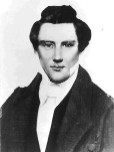
FAIR is a non-profit organization dedicated to providing well-documented answers to criticisms of the doctrine, practice, and history of The Church of Jesus Christ of Latter-day Saints.
(→: m) |
m |
||
| Line 22: | Line 22: | ||
Brodie quotes apostate Mormons for this claim. It does not, however, seem to match other facts in the historical record. In October 1836, Joseph Smith purchased a safe for use in the bank he and other Church leaders were planning: | Brodie quotes apostate Mormons for this claim. It does not, however, seem to match other facts in the historical record. In October 1836, Joseph Smith purchased a safe for use in the bank he and other Church leaders were planning: | ||
| − | :The safe measured only 25 by 24 by 29 inches. The dimensions of the safe cast a serious shadow on the validity of stories of various apostates cited by Brodie. They claimed that the shelves of the bank vault were lined with many boxes each marked $1,000. These many boxes were supposedly filled with sand, lead, old iron, and stone with only a thin layer of coins on top. As will be pointed out later [in the article], the founders of the bank probably had enough genuine specie when the bank was opened to fill the several small boxes that might have occupied this very modest safe.{{ | + | :The safe measured only 25 by 24 by 29 inches. The dimensions of the safe cast a serious shadow on the validity of stories of various apostates cited by Brodie. They claimed that the shelves of the bank vault were lined with many boxes each marked $1,000. These many boxes were supposedly filled with sand, lead, old iron, and stone with only a thin layer of coins on top. As will be pointed out later [in the article], the founders of the bank probably had enough genuine specie when the bank was opened to fill the several small boxes that might have occupied this very modest safe.<ref>{{BYUS1|author=Dale W. Adams|article=Chartering the Kirtland Bank|vol= 23|num=4|date=Fall 1983|start=479, n. 8.}} {{pdflink|url=http://byustudies.byu.edu/Products/MoreInfoPage/MoreInfo.aspx?Type=7&ProdID=885}}</ref> |
It is also telling that such apostates never disclosed Joseph's dishonesty before the bank's collapse, and some may have even participated in the bank. Why would they keep this a secret, and why would they risk their own financial well-being if they knew Joseph was up to no good? | It is also telling that such apostates never disclosed Joseph's dishonesty before the bank's collapse, and some may have even participated in the bank. Why would they keep this a secret, and why would they risk their own financial well-being if they knew Joseph was up to no good? | ||
| − | =={{Endnotes label}} | + | == == |
| − | + | {{Endnotes label}} | |
| − | + | <references /> | |
{{FurtherReading}} | {{FurtherReading}} | ||
| Answers portal |
| Joseph Smith, Jr. |

|
|
|
|
|
It is claimed that Joseph Smith misled investors in the Kirtland Safety Society by collecting boxes full of sand with money placed on top, in order to make it appear that the bank had more hard money than it did.
To see citations to the critical sources for these claims, click here
The Kirtland bank safe was not large enough to accommodate the claims which apostates later made. It seems plausible that in an effort to discredit Joseph Smith, they fabricated a story about him distorting the bank's reserves. Since such tales grow in the telling, and because a larger scam is more memorable, their creativity betrayed them—had they been more modest in their claims, the implausibility would be less apparent.
Without other evidence, this claim should be regarded as spurious.
Brodie quotes apostate Mormons for this claim. It does not, however, seem to match other facts in the historical record. In October 1836, Joseph Smith purchased a safe for use in the bank he and other Church leaders were planning:
It is also telling that such apostates never disclosed Joseph's dishonesty before the bank's collapse, and some may have even participated in the bank. Why would they keep this a secret, and why would they risk their own financial well-being if they knew Joseph was up to no good?
Notes

FAIR is a non-profit organization dedicated to providing well-documented answers to criticisms of the doctrine, practice, and history of The Church of Jesus Christ of Latter-day Saints.
We are a volunteer organization. We invite you to give back.
Donate Now